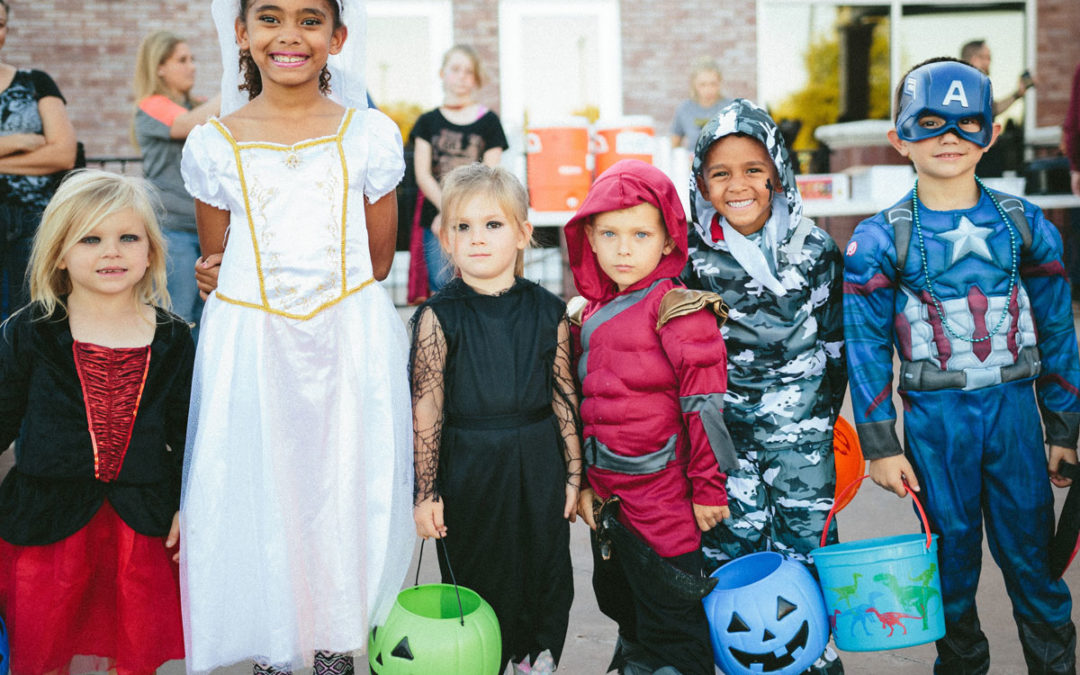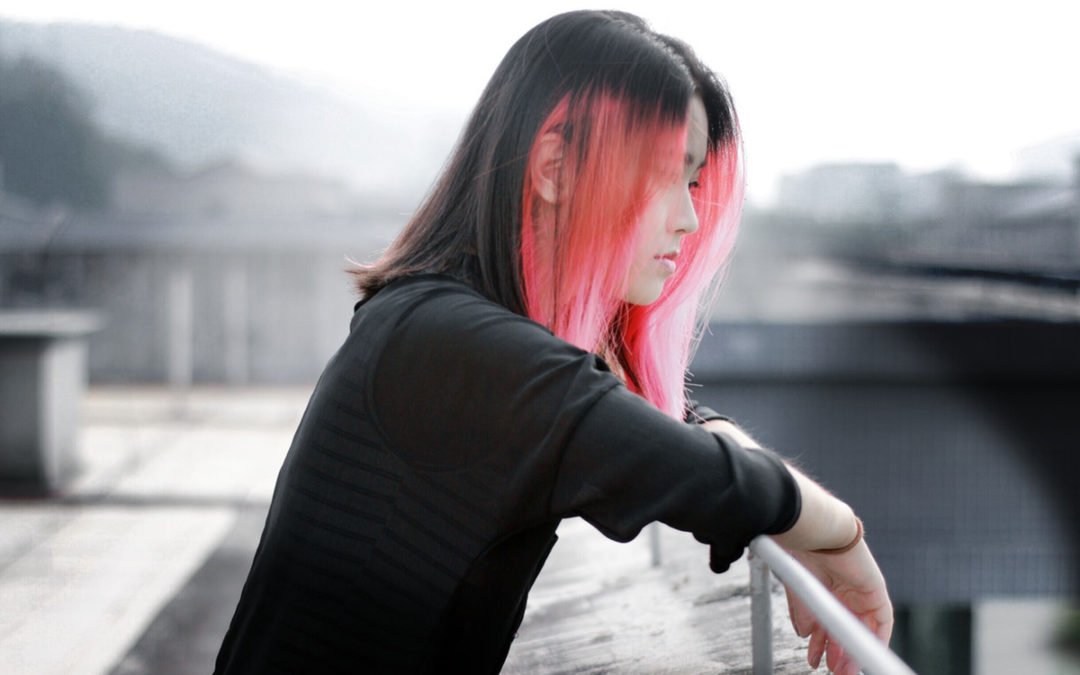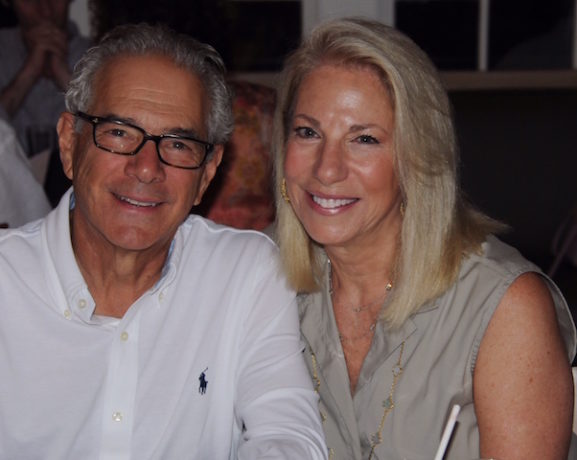
by North Shore Child & Family Guidance Center | Oct 30, 2018 | Blog
Halloween is one of the most exciting holidays of the year for youngsters. Candy, dressing up, parties at school—what’s not to love?
But if you have little ones, the sight of some of the scariest costumes and decorations is decidedly not something to celebrate.
“For children around three to five years of age, and sometimes even older, the ghoulish costumes and yard displays can be overwhelming and very scary, but that’s a natural part of their development,” says Dr. Sue Cohen, Director of Early Childhood and Psychological Services at North Shore Child & Family Guidance Center. “Luckily, most pre-schools and even elementary schools advise parents to avoid the scary kinds of costumes, so the schools themselves are typically safe zones. But once your child heads out to trick-or-treat, they’re likely to confront some frightening sights.”
Of course, you know your child, so you’re the best judge of how scared they are likely to be. But as with all parenting issues, preparing ahead of time and anticipating any problems is the wisest strategy. Some tips:
- Let them express the fears they have and reassure them in a calm voice that it’s OK to have those feelings.
- Play a game where your child scares you, and then laugh about it.
- Show them costumes online, so they’ll have an idea of what to expect.
- Do some crafts at home that create ghosts and other Halloween décor. Explain that any scary front lawn displays are made of fabric and paint, just like the crafts you made together.
- Some children don’t like something covering their faces, so you might want to avoid costumes with masks.
- If they are frightened by masks on other people, put one on yourself and take it off to show them that you are still there!
- If any older sibling is wearing a potentially scary costume, let your young one watch as they put on their makeup or masks, so they can gradually see how their big brother or sister transformed into the witch or warlock—and that it’s still them under the disguise.
- Make a visit to your local library and ask the librarian for books that help children see that Halloween is full of pretend things—some scary and others just plain fun! Click here for some great choices.
What about if your child just adores his or her costume but when Halloween arrives, their mood changes and they refuse to wear it? “Try a compromise,” advises Cohen. “Let them bring the costume to school instead of putting it on before they go, or have them just wear part of the outfit. It’s definitely not something worth having a power struggle over, so if they refuse to wear it, let it go.”
Sources:
https://www.parents.com/toddlers-preschoolers/development/fear/4-ways-to-make-halloween-less-scary/
https://www.washingtonpost.com/news/parenting/wp/2016/10/24/childrens-halloween-books-that-are-a-real-treat/?noredirect=on&utm_term=.d34809c07609
by North Shore Child & Family Guidance Center | Oct 24, 2018 | Anton Media, In The Media, Press Releases
Powerful images that depict disturbing events in ways that literature alone cannot can be illuminating and healing. Following are three descriptions of different media that capture recent man-made disasters, still very close to the surface for many of us.
The first, Please Stand By, is an example of cartoon art in the aftermath of 9/11. The second, The Last Lockdown, is about a sculpture created after the mass school shooting in Parkland, FL. Both illustrate the fear-inducing paralysis of traumatic events. The last, Memorial Rock Garden, describes bereaved children painting stones to memorialize their deceased dads.
Please Stand By
In the immediate aftermath of the September 11, 2001, terrorist attack on America, several artists joined together to produce a soft cover book titled 9/11: Artists Respond. It is a collection of art, sequenced to showcase the artists’ response to the terror that befell the world.
One nine-frame piece entitled “Please Stand By…,” by Jeph Loeb and J. Scott Campbell, features a girl of about 8 years old watching cartoons on television. By the third and fourth frames, the image on the screen changes to a live feed of the Twin Towers ablaze.
As the little girl stands transfixed, stuffed animal in hand and her face less than 12 inches from the screen, the commentator announces, “We interrupt this program to take you live…”
The little girl turns away and cries out, “Mommy!” The next three frames begin with her mother dropping a basket of laundry. Then, with her face contorted in anguish, she embraces her daughter to shield her from the unrelenting televised images.
The final frame is a close up of the little girl asking, “Mommy, when are the cartoons gonna come back on?”
The Last Lockdown
The next image is a haunting statue, as described by journalist Josh Hafner, of a “small girl cowering beneath an open school desk, clutching a leg as she gazes into the distance with a look of fear in her eyes.”
The sculpture was created by Manuel Oliver, an artist who lost his 17-year-old son Joaquin in the Parkland, FL, mass shooting earlier this year.
As Oliver said, “It’s too late for us to save Joaquin from gun violence, but through art, my family and I are making sure that we protect the rest of the kids out there.”
“Talking about the trauma is rarely if ever enough,” advises noted trauma expert Bessel van der Kolk. He points to the Holocaust Memorial in Jerusalem and the Vietnam War Memorial in Washington, D.C., “as good examples of symbols that enable survivors to mourn the dead and establish the historical and cultural meaning of the traumatic events to remind survivors of the ongoing potential for communality and sharing.”
Memorial Rock Garden
In 2002 at North Shore Child & Family Guidance Center, a group of boys and girls who lost fathers in the attack on the World Trade Center decorated stones to be placed in a memorial rock garden.
The kids in the bereavement group sat together around a table covered with newspaper. In front of each of them was a large smooth oval-shaped stone. They decorated the stones with unique designs of paint and glitter, each one a personal remembrance of their fathers.
“Mine is painted gold,” beamed Mack. “I painted it gold because my dad is like gold to me.”
A heart framed Jenny’s design, “because my dad will always be in my heart.”
On Seth’s stone were two intertwined hands, a small one and a larger one that showed “me and my dad were best friends.”
Victoria painted a fire hat and said, “My dad is my hero.”
We might do well to remember that when funding cuts threaten to decimate arts programs in schools there is more at stake then we might imagine. The impact of the arts is not measured by standardized tests and its value is incalculable.
Andrew Malekoff is the Executive Director of North Shore Child & Family Guidance Center, which provides comprehensive mental health services for children from birth through 24 and their families.
by North Shore Child & Family Guidance Center | Oct 23, 2018 | In The Media
I recently attended a seminar led by Dr. Cynthia Kaplan, director of Trauma Training & Consultation within the Child and Adolescent Services at McLean Hospital of Boston.
Dr. Kaplan addressed the issue of childhood sexual abuse. She incorporated the story of a young woman, Kayla Harrison, a survivor of CSA and a two-time Olympian Gold medalist in judo for the United States.
Many years ago CSA was only heard about in whispers as opposed to in-depth reports by investigative journalists. Today reports on CSA perpetrated by what seem like otherwise model citizens – religious leaders, coaches, teachers, seem commonplace.
Dr. Kaplan made a strong point about how we caution children in the strongest terms to “stay away from strangers,” yet 90 percent of children and adolescents, who are sexually abused, know their abuser.
Kayla’s book, “Fighting Back: What an Olympic Champion’s Story Can Teach Us about Recognizing and Preventing Child Sexual Abuse – and Helping Kids Recover,” co-authored by Drs. Kaplan and Aguirre, contains excerpts from Kayla’s personal journal.
She wrote about her experiences throughout the course of her abuse, including about how she was groomed by her coach.
“By the time I was nine or 10 I started traveling with the team to local tournaments. At night when the whole team would watch movies I would snuggle up next to him. He would put a blanket over us and then one day things went further and he guided my hand to touch him.”
About one in 10 children will be sexually abused before their 18th birthday.
The impact of CSA can be felt by survivors throughout their lifetime.
According to Dr. Kaplan, what complicates the healing is that CSA is not visible, not transparent. Consequently, survivors may not get the support they need and are often left to struggle and mourn alone.
When film director Steven Spielberg created the Shoah Foundation, which strives to capture the testimony of Holocaust survivors, he discovered that many of them had never told their stories before.
They often avoided doing so because they had a deep sense of shame and distress which they often believed could or would not be understood by others.
After the filming they reported feeling a sense of relief at finally having told someone. They finally felt heard.
Being truly heard requires another person to bear witness. Living with the hurt in silence can compound traumatic stress and lead to destructive and even fatal behaviors including drinking, drugging, self-harm and suicide.
Disclosures of CSA require professional support. When survivors lose their ability to control disclosures, the emotional impact can be devastating.
Even in the best of circumstances, says Dr. Kaplan, following disclosure individuals often feel more distressed and have trouble managing emotions. They may begin to lose faith in the world and can feel re-traumatized by the disclosure experience itself.
It is significantly more likely that a child will disclose if they know they are likely to be believed and do not feel blamed and also if they are helped to anticipate the potential legal repercussions of breaking their silence.
Believing that they will be protected by the adult they disclose to goes a long way. Particularly when they are able to maintain at least some control over the disclosure process, preserve their anonymity to the extent possible and sustain a level of confidentiality.
Surprising as it may seem, children also need to feel free to express their concerns about what will happen to the offender, as it is a complicated relationship with the victim having mixed feelings that survivors need time to process.
There is hope. As Kayla said, after many years and support from her new coaches, parents and mental health professionals, “I began to see my way out of the darkness and towards the light until I could again see the flame of the Olympic torch shining with my very own eyes.”

by North Shore Child & Family Guidance Center | Oct 17, 2018 | Blog
It’s not unusual for teens to have times when they feel down in the dumps. In fact, it would be abnormal if they never felt sad! But how do you know when “normal” sadness has developed into depression?
“Both children and teens are at risk of depression when they experience traumatic events in their lives, such as divorce, death of a loved one, abuse or illness,” says Elissa Smilowitz, LCSWR and Coordinator of Triage & Emergency Services at North Shore Child & Family Guidance Center.
But there isn’t always a dramatic event that triggers depression.
“Beginning around puberty, the risk of depression in teens increases,” says Regina Barros-Rivera, Associate Executive Director at the Guidance Center. “Their bodies are changing, and they’re experiencing hormonal fluctuations that can make them irritable and moody.”
Approximately 1 in 5 teens experience major depression, but about 60% do not receive treatment.
But moodiness doesn’t necessarily indicate depression, she adds. “It’s normal behavior for teens to begin separating from their parents and trying to become their own individuals. A certain amount of rebellion is common at this time, as they are attempting to determine and establish who they are.”
During the teen years, peers become the number one influence in each other’s lives, but that doesn’t mean your role as a parent is any less significant. “Even though you feel them pulling away, your teens still need you during this time,” says Barros-Rivera. “They are more likely to begin engaging in risky behavior, so your influence is as important as ever. They need you to help them develop good judgment.”
Along with adolescence comes a whole host of new pressures. Schoolwork, body image, sexual orientation and peer pressure all can combine to make a teen feel overwhelmed.
So, while moodiness is a hallmark for adolescents, how do you know when your teen is experiencing depression and might need professional treatment?
Here are some signs that may indicate depression:
- Withdrawal from friends and family
- Anxiety
- Low self-esteem
- Increased anger
- Worry about loss of control
- Crying often
- Inability to feel joy
- Changes in appetite (either increased or decreased)
- Sleeping more or less than usual
- Feeling tired
- Changes in grades or attitude toward school
- Having trouble concentrating
- Physical complaints like headaches or stomachaches
- Use of drugs and/or alcohol
- Expressing thoughts of suicide or wanting to die
Remember, it’s important that a medical doctor examine your teen since some symptoms of depression can have a physical cause such as thyroid problems, diabetes or other conditions. It may also run in families.
If you begin to see several of these symptoms lasting two weeks or more, contact a mental health professional. You can reach North Shore Child & Family Guidance Center at 516-626-1971.
Note: For some helpful tips on preventing depression in your child or teen, click here for an article from the Mayo Clinic.
Sources:
https://www.mayoclinic.org/healthy-lifestyle/tween-and-teen-health/in-depth/teen-depression/art-20046841
https://www.medicinenet.com/teen_depression/article.htm
https://www.nimh.nih.gov/health/statistics/major-depression.shtml

by North Shore Child & Family Guidance Center | Oct 15, 2018 | In The Media
Andrea and Michael Leeds and Americana Manhasset’s Champions for Charity® will be the honorees at North Shore Child & Family Guidance Center’s 65th Sapphire Anniversary Gala, which will take place Oct. 25 at the Garden City Hotel.
Andrea Leeds has been a board member at the Guidance Center for more than 20 years. She and her husband Michael have taken a leadership role in philanthropy and have been passionate, dedicated and committed supporters of the Long Island community.
Every holiday season, Americana Manhasset supports more than 100 not-for-profit organizations during its annual Champions for Charity® holiday shopping benefit, which this year takes place from Nov. 29 through Dec. 2. (Visit championsforcharity.org for free registration.) Since its inception in 1996, Champions for Charity® has raised nearly $12 million.

The co-chairs for this year’s gala are Matilde and Cliff Broder and Rosemarie and Mitchell Klipper. Journal co-chairs are Jo-Ellen Hazan and the recently deceased John Gutleber, who passed away unexpectedly in September. Auction co-chairs are Deirdre Costa Major and Charles Chan. The Mistress of Ceremonies is News 12 Long Island’s Carol Silva.
The gala will feature delicious food, live music, dancing and auction and raffle prizes. The speaker will be Linda Beigel Schulman, whose son Scott Beigel was murdered during the Parkland, Fla. tragedy.
“For 65 years, the Guidance Center has been committed to providing essential mental health services to all children and families, regardless of their ability to pay,” says Executive Director Andrew Malekoff. “The generous support of our honorees, donors and sponsors at the gala will help us maintain the highest standard and quality of care to our community.”
All proceeds will benefit the Guidance Center. To learn more about becoming a sponsor or an underwriter or purchasing tickets, visit www.northshorechildguidance.org/events, call 516)-626-1971 ext. 337 or email development@northshorechildguidance.org.




